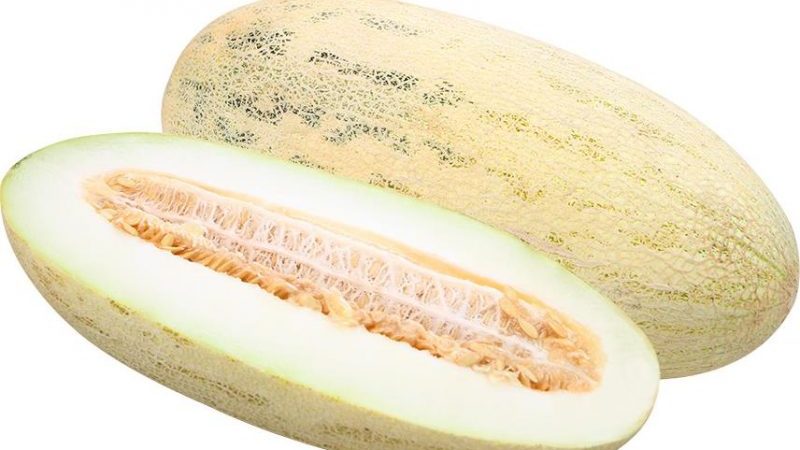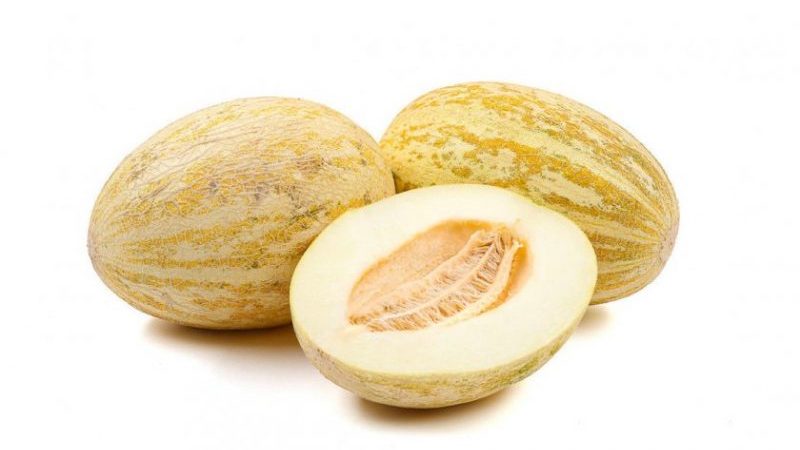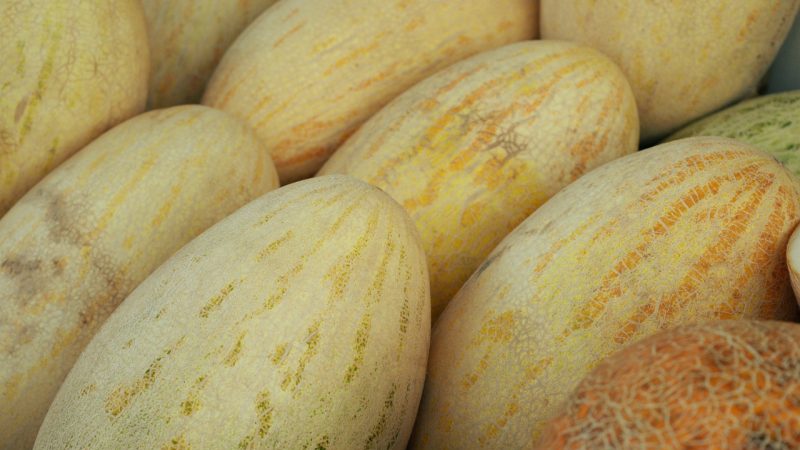The most popular and beloved by many melon "Torpedo": we choose the right one and grow it ourselves
Melon Torpedo is a favorite of many. Delicate and juicy, with excellent taste and sweet pleasant aroma. Many gardeners dream of growing a rich harvest of this melon.
Let's take a closer look at what the Torpedo variety is and how to get a tasty harvest on your own plot.
The content of the article
Melon variety description
The variety got its name for its elongated oblong shape. His homeland is Uzbekistan, in this country torpedo melon can be found in every yard. The plant likes a warm climate and fertile nutritious land.

Distinctive features
Late-ripening melon ripens 90-100 days after planting. The culture is grown in both seedling and non-seedling methods.
The plant has many lashes, small leaves of light green color. Melon is thermophilic, therefore it is recommended to plant it in fertile and sunny beds.
Fruit characteristics and yield
The surface of the melon is yellow, with a white embossed mesh. The shape is elongated, the weight of the fruit is about 5 kg. The skin is thick, resistant to damage, so the torpedo can be stored for a long time without losing its useful properties.
The pulp is very aromatic and sweet, creamy white. The yield is high - from 1 sq. m collect from 5 to 7 kg of tasty sugar fruits.
Composition, properties, calorie content and benefits
Why is melon good for health? After all, it is recommended even for the preparation of dietary meals. The fragrant juicy fruit has a valuable supply of vitamins and minerals such as calcium, potassium, phosphorus, iron, zinc.
90% of the pulp is liquid, so you can eat it even if you are overweight. 100 g contains 34 kcal.
Of the beneficial properties of melon, the following are noted:
- removes toxins and toxins from the body;
- increases the level of hemoglobin in the blood;
- has a rejuvenating effect;
- vitamin C in the melon has an antimicrobial effect;
- vitamin B is responsible for the healthy functioning of the gastrointestinal tract.
How to choose fruits when buying
When choosing a Torpedo in a store or on the market, it is important to pay attention to its appearance. The melon must be large and firm, free from scratches or other damage... A characteristic sign of maturity is dull sound when tapped.

Aroma is also of great importance. The ripe has a strong characteristic smell; if it is not there, then the fruit is not yet ripe. The ponytail should be firm and dry.
Important! Be careful when shopping in roadside tents. Often the fruits lie on bare ground, which can cause dangerous infections. Eating such melon can lead to poisoning.
How to grow yourself
The Torpedo variety is grown in two ways: seedling and seedless. The first is suitable for regions with short summers and abrupt weather changes; the second is for warm and temperate climates. Let's consider each method in detail and learn the secrets of growing.
Landing
The necessary preparation stage is disinfection. Seeds are disinfected with aloe juice, Bordeaux liquid, succinic acid solution. The seed is soaked for 24 hours, and then placed in a wet napkin for germination. Germination shows the germination of seeds, increases their immunity.
Then do one of the following:
- With the seedling method, seeds are planted in prepared soil in any convenient container (flower pot, plastic cups, peat tablets). Seedlings are grown for 2-3 weeks in a warm and sunny place. It is recommended to keep it near a battery or on a windowsill. Water the seedlings as the earth dries up, only with warm water. When transplanting into the garden, the sprouts are carefully placed in the beds dug up and cleared of debris.
- With the seedless method, the seeds after disinfection are immediately planted in the garden. Previously, the earth is dug up, fertilized with liquid manure or vermiculite - a mineral that increases germination. During the first week after planting, each sprout is covered with plastic to protect it from winds and cold snaps. Melon loves a mixture of sandy loam and loamy soils, so it is important to choose the right planting site.
Care
The basis of any care is timely and competent watering. The beds are moistened once every 5–7 days only with warm water (the optimum temperature is about +18 ° C). 2 liters are spent on one bush. If the summer is hot and rainy, the amount of water is reduced.
Once every 2 weeks, instead of ordinary water, watering is used for an infusion of burdock or nettle. They protect against disease and prevent the development of weeds. Before each watering, it is recommended to loosen the soil so that the water gets as deep as possible into the roots.
The second element of healthy melon development is the organization of feeding. Both organic substances and mineral complexes are used. Fertilize the Torpedo variety 1 time in 10 days.
Preference is given to the following dressings:
- dry wood ash;
- liquid bird droppings;
- urea;
- superphosphate;
- potassium monophosphate;
- mineral complex "Kimira";
- growth stimulants "Kornevin" or "Heteroauxin";
- spraying with milk whey solution.
Important! Do not forget about loosening and removing weeds. These treatments make the soil more nutritious and lighter, protect against pests and maintain a healthy flora in the garden beds. Loosening is carried out once a week. The recommended depth is 10-15 cm.
Features of cultivation and possible difficulties
In the northern regions of the country, torpedo melon is grown mainly in greenhouses or hotbeds... Polycarbonate designs are great. They are lightweight, sunshine permeable, affordable and easy to install. Before planting in the greenhouse, all hard surfaces are disinfected with a solution of potassium permanganate. The structure is characterized by heat and high humidity, so it is important to monitor the condition of the earth. The greenhouse is ventilated daily by opening the vents.
Mandatory procedure — formation bushes and pinching the top. As soon as 5 leaves appear, the shoot above the fourth leaf is removed. In the future, it is important to leave two main shoots above each leaf, no more.
Long lashes are untangled and laid on the ground, sprinkled in several places. Under the largest and largest fruits, they put a support of wooden boxes and stones. This is done so that melons do not rot on contact with wet soil.
Diseases and pests characteristic of the variety
Melon Torpedo is resistant to major crop diseases. However, occasionally, even with all agrotechnical rules, she gets sick with anthracnose. The leaves are covered with brown and yellow spots, wither and dry out. If measures are not taken in time, the melons will deform and rot. For prophylaxis, spraying with a solution of milk and iodine is used (for 5 liters of water, 500 ml of milk and 20 g of iodine). If the disease has already appeared, the plant is treated with Bordeaux liquid or sulfuric solution.
Another disease of the variety is powdery mildew. It manifests itself in the form of a white bloom on the leaves, which becomes more and more every day. There are several reasons for infection: high nitrogen content in the soil, sudden temperature changes, high humidity, dense planting. To combat powdery mildew, use the drugs "Bravo" or "Mikosan".
The melon fly is the most common pest in the garden.... A miniature insect appears due to contaminated soil or improper care. The fly lays larvae in the fruit, which eat the melon from the inside. It is impossible to detect an insect with the naked eye, therefore it is recommended to regularly inspect the bushes in sunlight. Copper sulfate or Topaz is used to combat the pest.
Harvesting and application of the crop
Harvest in mid - late August. Ripe is identified by its sweet aroma and hard rind... It is recommended to pluck the fruits together with the stalk to keep their taste and freshness longer. The melon is wiped with a dry cloth and laid out on the beds for 2-3 days, then removed to the cellar or basement. It is important that the room is regularly ventilated. If you overexpose the crop in the beds, the taste begins to taste bitter.
A variety of torpedo melons are prepared snacks and desserts: cakes, cocktails, fruit salads, smoothies and sorbets. The fruit goes well with ice cream and mint, quenches thirst. Part of the crop is consumed fresh, the other is used for cooking dishes... The sweet pulp is harmoniously combined with milk porridge.

Advantages and disadvantages of the variety
The advantages of the Torpedo variety include juicy and tender pulp, excellent taste, versatility in application. The product has a low calorie content, contains useful vitamins and minerals. Eating melon can help fight stress, relieve tension and fatigue. The Torpedo variety consistently shows a high yield.
Of the shortcomings, they note the fact that the torpedo is grown only in the southern regions of the country. In areas with temperate and cold climates, the variety does not have a high yield. Another disadvantage is the need to form a bush.
Reviews of summer residents
Despite the fact that the torpedo melon is one of the most popular in our country, there are also mixed reviews about it.
Galina, Samara: «I have been growing Torpedo melon for five years in a row. Always happy with the harvest. Melons are large, fragrant, very sweet. I love to eat them fresh until they go bad. "
Maria, Rostov-on-Don: “I planted the Torpedo variety for the first time. I followed the care recommendations: watered and fertilized on schedule, formed a bush and pinched the top. However, in mid-July, the plant got sick with powdery mildew. We managed to cure it, but part of the harvest was lost. "
Dmitry, Sochi: “I recommend Torpedo to anyone who hasn’t tried it yet! Melon makes delicious desserts. I make fruit salads and fresh juices, both adults and children like them. A selection of dishes for every taste ”.
Read also:
Why Ethiopka melon is good and why it is worth trying to grow it yourself.
How does melon affect the intestines: weakens or strengthens?
Conclusion
Finding the right variety for growing is not easy. Melon Torpedo is known to any gardener. It not only has a rich taste, but is also healthy. It is planted by both beginners and experienced gardeners.
If by the end of summer you want to get a harvest of tasty healthy fruits from your beds, the Torpedo variety is exactly what you need.